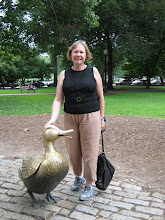Many of the children I teach know of Beatrix Potter because of her character Peter Rabbit, and most of them know of him because of movies and modern interpretations of her books that are not illustrated by Beatrix. When I show my students what the books looked like when they were first published they make comments such as 'they are so small'; 'there is so much white'; 'they're so cute'. Then when we look at the copyright page of The Tale of Peter Rabbit and see that it was first published in 1901, and then they work out how long ago that was they are very quiet. 'Is it the oldest book in the library?'
To celebrate Beatrix Potter's birthday I often get out the old books, whatever new versions and spin-offs we have and collect together some picture book biographies to make a display. Then I add some toys. The library has Peter, Jemima and Mrs Tiggy-Winkle.
Newer biographies:
Beatrix and Her Bunnies (2021) by Rebecca Colby & Caroline Bonne-MullerBeatrix loves the countryside, but lives in a big, lonely house in London - if only she had a friend. Then she meets Benjamin Bunny and everything changes!
Rebecca Colby effortlessly entwines the fascinating threads of Beatrix Potter's life: her deep connection with animals, her development as a writer and artist, her determination to be published and her role as a pioneering conservationist.
Beatrix Potter, Scientist (2020) by Lindsay H. Metcalf & Junyi Wu
Everyone knows Beatrix Potter as the creator of the Peter Rabbit stories. But before that, she was a girl of science. As a child, Beatrix collected nature specimens; as a young adult, she was an amateur mycologist presenting her research on mushrooms and other fungi to England's foremost experts. Like many women of her time, she remained unacknowledged by the scientific community.
Saving the Countryside (2020) by Lindsay Marshall & Ilaria Urbinati
Growing up in London, Beatrix Potter felt the restraints of Victorian times. Girls didn't go to school and weren't expected to work. But she longed to do something important, something that truly mattered. As Beatrix spent her summers in the country and found inspiration in nature, it was through this passion that her creativity flourished.
There, she crafted The Tale of Peter Rabbit. She would eventually move to the countryside full-time, but developers sought to change the land. To save it, Beatrix used the money from the success of her books and bought acres and acres of land and farms to prevent the development of the countryside that both she and Peter Rabbit so cherished. Because of her efforts, it's been preserved just as she left it.
There are some older biographies too:










No comments:
Post a Comment